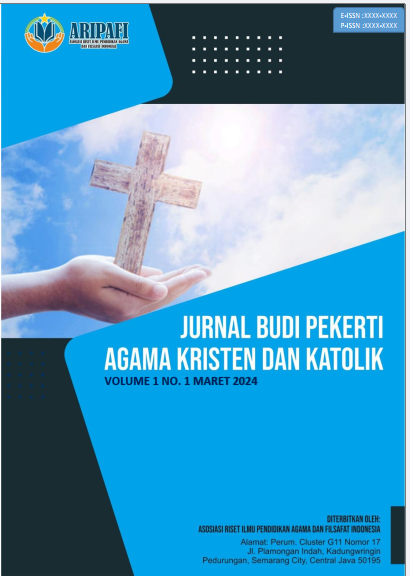Peran Teknologi Pembelajaran pada Desain Pembelajaran
DOI:
https://doi.org/10.61132/jbpakk.v2i4.773Keywords:
Learning Technology, Learning Design, Digital EraAbstract
In the digital era, technology plays an important role in designing learning that is more interactive, personalised and adaptive. This research examines the role of learning technology in learning design through a qualitative approach based on a literature review. The use of technology, such as Learning Management Systems (LMS), virtual reality (VR), and artificial intelligence (AI), shows potential to increase student engagement as well as provide a more flexible learning experience. Blended learning approaches are also proven to increase engagement and provide flexibility in the learning process. In addition, technology supports competency-based learning that enables real-time evaluation of student progress through learning analytics. However, there are challenges in implementing technology, such as the digital divide, teacher readiness, and infrastructure limitations. Therefore, the successful integration of technology in learning design requires support from educational institutions and policies to provide adequate training for teachers and appropriate technology infrastructure. This study concludes that technology integration in learning design provides significant benefits in improving learning quality, but still requires a systematic and adaptive approach.
Downloads
References
AECT. (2017). Educational technology: A definition with commentary. AECT.
Alqurashi, E. (2019). Predicting student satisfaction and perceived learning within online learning environments. Distance Education, 40(1), 133–148. https://doi.org/10.1080/01587919.2019.1570155
Awiria, A., Prawira, A. Y., Dariyanto, D., & Pujayanah, I. S. (2022). Pelatihan mengembangkan evaluasi pembelajaran inovatif menggunakan Google Form, Kahoot, dan Quizziz di sekolah dasar. Jurnal Pendidikan dan Kebudayaan, 9(1), 1–11. https://doi.org/10.32699/ppkm.v9i1.2173
Bates, A. W. (2015). Teaching in a digital age: Guidelines for designing teaching and learning. BCcampus.
Briggs, K. (2005). Establishing a high-frequency standard reference sequence stratigraphy, sea-level curve, and biostratigraphy for Morrowan strata of the Lower Absaroka I time slice based upon the Bird Spring Formation, Arrow Canyon, Nevada. Unpublished manuscript.
Briggs, L. J. (1986). Instructional design: Principles and applications. Educational Technology Publications.
Dick, W., & Carey, L. (1996). The systematic design of instruction. HarperCollins.
Gustafson, K. L., & Branch, R. M. (2002). Survey of instructional development models (4th ed.). Syracuse University.
Hadi, R. (2023). Implementasi strategi manajemen kelas yang efektif dalam meningkatkan pembelajaran di sekolah dasar. Jurnal Pendidikan Dasar, 8(2), 1–12. https://doi.org/10.58258/jupe.v8i2.5512
Heinich, R., Molenda, M., Russell, J. D., & Smaldino, S. E. (1999). Instructional media and technologies for learning. Prentice-Hall.
Hrastinski, S. (2019). What do we mean by blended learning? TechTrends, 63, 564–569. https://doi.org/10.1007/s11528-019-00375-5
Johnson, L., Becker, S. A., Estrada, V., & Freeman, A. (2016). NMC Horizon report: 2016 higher education edition. The New Media Consortium.
Kirkwood, A., & Price, L. (2014). Technology-enhanced learning and teaching in higher education: What is “enhanced” and how do we know? A critical literature review. Learning, Media and Technology, 39(1), 6–36. https://doi.org/10.1080/17439884.2013.770404
Mayer, R. E. (2009). Multimedia learning (2nd ed.). Cambridge University Press.
Mazrur, M. (2011). Teknologi pembelajaran. Intimedia Publishing.
Mishra, P., & Koehler, M. J. (2020). Technological pedagogical content knowledge: A framework for teacher knowledge. Educational Technology Research and Development, 68, 673–685. https://doi.org/10.1007/s11423-020-09762-4
Rogers, E. M. (2003). Diffusion of innovations. Free Press.
Romiszowski, A. J. (1981). Designing instructional systems: Decision making in course planning and curriculum design. Kogan Page.
Salmon, G. (2013). E-tivities: The key to active online learning. Routledge.
Selwyn, N. (2019). Should robots replace teachers? AI and the future of education. Polity Press.
Siemens, G., & Long, P. (2020). The impact of learning analytics on higher education: Future trends and ethical implications. Educational Technology Research and Development, 68(3), 931–946. https://doi.org/10.1007/s11423-020-09759-z
Sirait, R. A., Sukarna, T., & Dewi, E. Y. (2024). Pandangan Efesus 4:11-16: Kepemimpinan pelayanan yang terdepan di era digital. Jurnal Silih Asah, 1(1), 46–53. https://doi.org/10.32699/jsa.v1i1.1234
Veletsianos, G., & Houlden, S. (2020). Radical flexibility and relationality as responses to education in times of crisis. Postdigital Science and Education, 2(3), 849–862. https://doi.org/10.1007/s42438-020-00080-1
Zawacki-Richter, O., Marín, V. I., & Bond, M. (2019). Systematic review of research on artificial intelligence applications in higher education – Where are the educators? International Journal of Educational Technology in Higher Education, 16(1), 1–27. https://doi.org/10.1186/s41239-019-0176-8
Downloads
Published
How to Cite
Issue
Section
License
Copyright (c) 2024 Jurnal Budi Pekerti Agama Kristen dan Katolik

This work is licensed under a Creative Commons Attribution-ShareAlike 4.0 International License.





